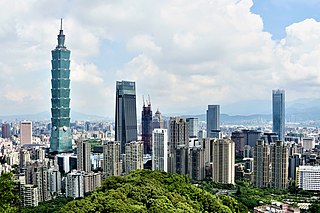
Bubble tea is a tea-based drink that originated in Taiwan in the early 1980s. Taiwanese immigrants brought it to the United States in the 1990s, initially in California through regions including Los Angeles County, but the drink has also spread to other countries where there is a large East Asian diaspora population.

The Kuomintang (KMT), also referred to as the Guomindang (GMD), the Nationalist Party of China (NPC) or the Chinese Nationalist Party (CNP), is a major political party in the Republic of China, initially based on the Chinese mainland and then in Taiwan since 1949. The KMT is a centre-right to right-wing party and the largest in the Pan-Blue Coalition. Its primary rival is the Democratic Progressive Party (DPP) and its allies in the Pan-Green Coalition. As of 2024, the KMT is the largest single party in the Legislative Yuan. The current chairman is Eric Chu.

Taiwan, officially the Republic of China (ROC), is a country in East Asia. It is located at the junction of the East and South China Seas in the northwestern Pacific Ocean, with the People's Republic of China (PRC) to the northwest, Japan to the northeast, and the Philippines to the south. The territories controlled by the ROC consist of 168 islands with a combined area of 36,193 square kilometres. The main island of Taiwan, also known as Formosa, has an area of 35,808 square kilometres, with mountain ranges dominating the eastern two-thirds and plains in the western third, where its highly urbanized population is concentrated. The capital, Taipei, forms along with New Taipei City and Keelung the largest metropolitan area. With around 23.9 million inhabitants, Taiwan is among the most densely populated countries.

Taiwanese indigenous peoples, also known as Formosans, Native Taiwanese or Austronesian Taiwanese, and formerly as Taiwanese aborigines, Takasago people or Gaoshan people, are the indigenous peoples of Taiwan, with the nationally recognized subgroups numbering about 569,000 or 2.38% of the island's population. This total is increased to more than 800,000 if the indigenous peoples of the plains in Taiwan are included, pending future official recognition. When including those of mixed ancestry, such a number is possibly more than a million. Academic research suggests that their ancestors have been living on Taiwan for approximately 15,000 years. A wide body of evidence suggests that the Taiwanese indigenous peoples had maintained regular trade networks with numerous regional cultures of Southeast Asia before the Han Chinese colonists began settling on the island from the 17th century, at the behest of the Dutch colonial administration and later by successive governments towards the 20th century.

Taipei, officially Taipei City, is the capital and a special municipality of Taiwan. Located in Northern Taiwan, Taipei City is an enclave of the municipality of New Taipei City that sits about 25 km (16 mi) southwest of the northern port city of Keelung. Most of the city rests on the Taipei Basin, an ancient lakebed. The basin is bounded by the relatively narrow valleys of the Keelung and Xindian rivers, which join to form the Tamsui River along the city's western border.
The controversy surrounding the political status of Taiwan or the Taiwan issue is an ongoing dispute on the political status of Taiwan, currently controlled by the Republic of China (ROC). This dispute arose in the mid-twentieth century.
"Chinese Taipei" is the term used in various international organizations and tournaments for groups or delegations representing the Republic of China (ROC), a country commonly known as Taiwan.

The Chinese people, or simply Chinese, are people or ethnic groups identified with China, usually through ethnicity, nationality, citizenship, or other affiliation.
Camptoloma is a genus of moths in the family Nolidae. It was formerly incorrectly placed in Arctiidae.
Camptoloma interiorata is a moth of the family Nolidae. It is found in China, Japan, the Korean Peninsula and the Russian Far East.
Camptoloma binotatum is a moth of the family Nolidae. It is found in northern India and Assam, Nepal, Myanmar and southern China.

Camptoloma carum is a moth of the family Nolidae. It is endemic to Taiwan.
Camptoloma vanata is a moth of the family Nolidae. It is found in Jiangxi and Hainan in China and in northern Vietnam.
Camptoloma mangpua is a moth of the family Nolidae. It is endemic to Sikkim.
Camptoloma kishidai is a moth of the family Nolidae. It is endemic to Guangdong in China.
Camptoloma bella is a moth of the family Nolidae. It is endemic to Guangxi in China.

Camptoloma mirabilis is a moth of the family Nolidae first described by Roepke in 1943. It is found on Java, Peninsular Malaysia and Borneo. The species is found in montane habitats.
Camptoloma tigrinus is a moth of the family Nolidae first described by George Hampson in 1894. It is found in India (Assam) and Myanmar.

Camptoloma is a genus of flowering plants in the family Scrophulariaceae. It includes four species of annuals, subshrubs, and shrubs native to the Canary Islands, Somalia and the southern Arabian Peninsula, and Angola and Namibia.
Camptoloma is the scientific name of two genera of organisms and may refer to:
This page is based on this
Wikipedia article Text is available under the
CC BY-SA 4.0 license; additional terms may apply.
Images, videos and audio are available under their respective licenses.








